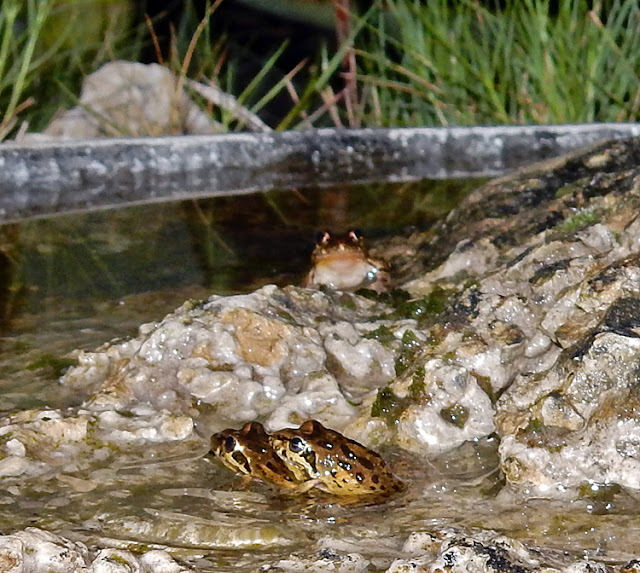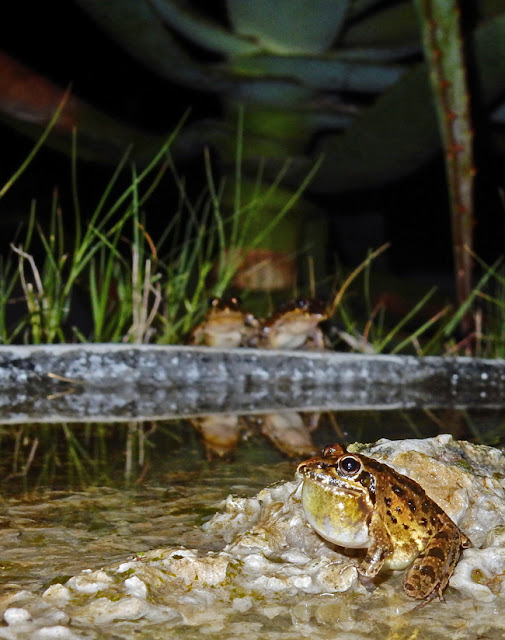Earlier this year, over Easter, I spent a week at the family holiday home in the Eastern Cape and thought I'd share some photographs of our resident frogs.
 |
| Clicking Stream Frog (Kliklangtoonpadda - Strongylopus grayii) at the Woody Cape |
A few years ago I bought a container to use as a small garden pond. The idea was to entice birds and other animals to visit the garden more frequently. Initially it had only limited success, but then about a year ago I finally got around to redirecting the rainwater from one of the gutters to flow into the pond. As a result it now has almost constant water and the water quality is also much better than before, because of the extra rain water that regularly trickles into the pond.
 |
| The small pond with the rain water pipe on the left, I added stones to provide a foothold for visitors |
A few months later I noticed a dramatic increase in bird activity at the pond, including some new species I haven't seen on the property before. The "new and improved" pond is a major hit!
Most of all I was happy to find the local Clicking Stream Frogs also approving of the improvements made to the pond. Their original home, the puddle in the ditch at the side of the road, got destroyed during all the construction work when the house was being built, and I always felt a little bad about it.
Now they are back and at night you can hear them merrily clicking away at the pond (their call makes a clicking sound).
They usually like to hide away in the vegetation next to the pond, but some brave frogs venture onto the rim of the pond or even take up center stage on the submerged stones.
 |
| After the initial dash for cover, the bravest of the frogs were quick to scramble back and resume their clicking |
I was surprised to find so many frogs living at the pond. They were quite entertaining characters to observe. Every now and again when two males couldn't settle things peacefully via a clicking competition, the one would suddenly tackle the other sitting next to him and both would fall off the edge, into the grass below. For the next 10-30 seconds the grass stalks would twitch frantically, accompanied by the cutest , yet clearly very serious, grunts as they wrestle each other on the ground. Eventually one of the tiny frogs would emerge victorious, and climbing back over the edge of the pond reclaim his spot. Soon he'll be clicking again, to his harts content, free of the troublesome contender next to him, for a while.
On a particularly romantic evening, by frog standards, I decided to sneak down to the pond with my camera and was greeted by this steamy scene.
 |
| Some prefer to watch, others prefer to be watched... |
The Clicking Stream Frog is a common species and found throughout much of South Africa, mostly at lower elevations along the Eastern and Southern coast and some distance inland. In fact, I've even photographed one about 750 km away at Koeberg Nature Reserve.
 |
| I found this Clicking Stream Frog at Koeberg Nature Reserve |
Unlike the frogs in the pond at the Woody Cape the individual at Koeberg had a large dorsal stripe. This is a know color variation for the species. I'm not sure whether the pattern is more common in certain parts of the species' range or not, but I didn't notice any frogs with noticeable dorsal striping at the Woody Cape pond.
Despite their name "stream frog" they are actually mostly ground dwelling and might even die if they can't get out of the water after a few hours (because they absorb too much water through their skin). As such they don't live in the streams itself, but rather along the damp and dense vegetation on the stream banks.
In fact, they have a very large habitat and water quality tolerance and will breed in very small puddles far away from actual streams. They even prefer to lay their eggs outside of water, up to 30 cm away. These eggs can survive up to a few months waiting for wet weather conditions. During suitable weather the tadpoles emerge from the eggs and somehow work their way into the pond itself where the they can grow and develop into proper frogs.
It is hard to tell from some of the photos, but these guys are fairly small, only 3 - 4.5 cm long. The sexes look more or less the same, except that the females are a bit larger and the males have a golden tint on their lower jaws and throat.
Apparently these tiny frogs even managed to end up on Saint Helena island, 3000 km from their natural distribution range. I wonder how they got introduced to the island and what impact they might be having on the native species?
 |
| Fans and critics alike could be found on the ringside seats, while the star of the show was performing center stage |
When I get back from holiday I hope to share some of the interesting things I saw, and then I want to get started on some proper camera trapping projects again. It has been too long since I placed any of my camera traps outdoors.
Fascinating. Answered ll my quetions & more!
ReplyDeleteStunning. I saw some last night. Lambert's bay.
ReplyDelete